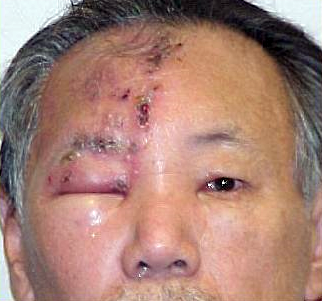 |
Low follow-up rates for HZO might be combatted through physicians educating patients about late-onset ocular complications that can occur. Photo: Alan Kabat, OD. Click image to enlarge. |
In a study appearing in Cornea, researchers recently sought to better understand how herpes zoster ophthalmicus (HZO) is initially managed in the United States. To do this, they studied trends in treatment from 2010 to 2018 and compared results with the treatment preferences of cornea specialists.
Individuals who received a new HZO diagnosis in this timeframe were included, and an online survey was distributed to Cornea Society members relating to HZO management perspectives. Outcomes assessed included the proportion of cases with systemic antiviral prescriptions, type of eyecare provider and involvement and follow-up visits after initial diagnosis.
Only half of patients at initial HZO diagnosis were given systemic antivirals the day of or within seven days. Of this percentage, 45.6% were given the antivirals the day of and 53.7% within a week. Initial diagnoses were mostly made by ophthalmologists (45%), then by optometrists (19.2%) and general practitioners. At least one follow-up visit to any provider type within 30 days occurred in 48.7% of cases. The ophthalmology referral rate was 38.6% within a year of initial diagnosis.
Compared with these outcomes, 97% of cornea specialists would have prescribed systemic antivirals to any patients with ocular involvement, while only 66% would provide antivirals to those without ocular or eyelid involvement. A follow-up within a month of diagnosis was recommended by 70% of corneal specialists.
The study researchers noted that consensus in the literature is to administer systemic antivirals for HZO within 72 hours of rash onset, which decreases the risk of ocular complications, acute pain severity and viral shedding. However, the FDA labels on approved antivirals further specify that treatment is most effective when initiated within 48 hours of rash onset, while treatment efficacy when initiated at 72 hours is not established.
Despite this, the researchers pointed out there is no evidence against the benefits of initiating treatment after this point. They make the case that “given the good safety profile of systemic antivirals and absence of appropriate outcome metrics, utilization of oral antivirals should not be limited to the traditional 72-hour window.” Adding to the reason for this recommendation is the low risk of antiviral side effects and highly variable DNA shedding of the virus, which can be detectable up to 34 days after initial rash onset.
Following this logic, the authors noted that one prior study did suggest potential benefits with treatment after the 72-hour window, including decreased ocular complications, less acute dermatomal pain and decreased incidence of new skin lesions when compared with placebo.
While many recommendations press for follow-ups, the low rate observed in this study may be reflective of the lack of clarity in follow-up frequency, timing and provider type.
To combat any ocular involvement that is typical within two to four weeks after onset, the authors believe “it would be beneficial to have at least one follow-up within a month and ascertain the necessity of” referral to an appropriate specialist. “Future guidelines would ideally address optimal follow-up.”
Lu A, Sun Y, Porco TC, et al. Practice patterns in the initial management of herpes zoster ophthalmicus in the United States. Cornea. March 23, 2023. [Epub ahead of print]. |


